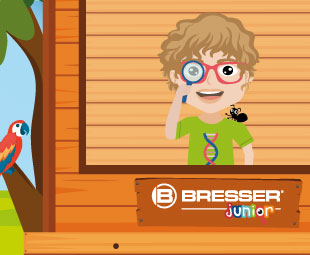You are here: / Bresser Junior / Lukas
table of contents
Structure of a microscope
A microscope offers a unique opportunity to view your favourite objects up close and in more detail. There are two main types of microscope, reflected light microscopes and transmitted light microscopes.
Specimens
Making a permanent specimen
Watering can, fountain, stream – can’t wait to investigate the water from your garden or a park? Then take a water sample and let us prepare a specimen for your microscope so that you can take a closer look at what’s swimming around.
All you need to do is take a slide and add one or two drops of your sample with a pipette. Then place a coverslip over the slide. If necessary, press down slightly on the coverslip. You can remove the excess water with filter paper.
Would you like to colour your finished sample? If so, use a drop of ink from a normal ink cartridge, e.g. from your fountain pen. Place the ink on the left or right edge of the coverslip covering the slide. Hold a piece of blotting or filter paper on the opposite edge. As you will see for yourself, the ink will be absorbed and colour the entire sample. Now you are ready to inspect your first specimen – let’s go!
Preparing specimens - thin section
Did you find an interesting leaf during your last walk in the forest that you want to look at more closely under the microscope? If so, there’s much more to look at than just the surface. The inside of your leaf will also have all sorts of exciting things to discover.
I will show you how to make a thin section so that you can take a closer look inside the leaf:1. Take a large carrot and cut off the tip.
2. Ask an adult to help you so that you don’t cut yourself.
3. Then cut a slit across the carrot in the place where you removed the tip. Place your leaf into the slit. To obtain a smooth edge, cut a small piece off the tip.
4. Then carefully peel off a piece of the carrot with a peeler to obtain a thin piece (thin section) of your leaf.
5. Add a drop of water to a slide and place the thin section onto the slide using a pair of tweezers. Now place the coverplate on top. You are now all set to start your investigations!
Your first observation
Lukas will show you how to make your first microscopic observations a resounding success!
1. Sit in front of your microscope and turn the tube towards you.
2. What would you like to look at first? To begin with, try something like a strand of hair or a pre-prepared specimen. Then place your specimen on the stage. Ensure that there is a sufficient gap between your specimen and the nosepiece, otherwise the lenses may get scratched.
3. Then choose the objective with the smallest magnification and turn it so that it is pointing at your sample. Important: When adjusting the nosepiece, always look from the side to check that there is a sufficient gap between the objective and the specimen. This allows you to better gauge the distance and ensure that you protect the sample as well as the lenses.
4. To adjust the focus, look through the eyepiece and turn the wheel on the side until the object comes into focus.
5. You can now move the slide with your sample back and forth on the stage to get a close-up view of every detail!
6. When you find something interesting, move the objective to the next magnification level. Look again from the side to check that there is a sufficient gap between the slide and the lens. Each objective will bring you closer to your discovery!
7. Finally, don’t forget to enter your exciting observations in your microscope journal.
The structure of a cell
Cells are the building blocks of all living things. You and everything inside you also consists of cells – a mind-boggling number of them! For example, a person weighing 70 kg has about 30 billion cells. Incredible, right? Nature is also made of these tiny structures. Every animal, tree and plant is made of cells. But what does a cell really look like? Let’s take a look in more detail!
Cell membrane – This is the outer edge of the cell and ensures that the cell is an enclosed space.
Cell plasma or cytoplasm – This is the liquid in the cell, which consists primarily of water as well as protein, nutrients, sugar and salts.
Nucleus – This is the largest cell organelle and contains the DNA, the blueprint for the living organism.
Endoplasmic reticulum (ER) – This is located around the nucleus and produces building blocks for the cell, such as proteins.
Golgi apparatus – This ensures that the different building blocks are transported from the ER to the Golgi apparatus and then on to their final destination. You can think of it as a post office.
Vesicle – These function like balloons, in which the building blocks are transported through the cell. They work like postmen who deliver parcels.
Mitochondria – This is the powerhouse of the cell where cell respiration occurs and energy is produced that the cell requires for survival.
Chromoplast – These provide the colour for the flowers and fruits of the plant.
Chloroplasts – These colour the cell green and conduct photosynthesis, i.e. convert carbon dioxide into oxygen.
Vacuole – This is a cavity within the cell that is filled with cell plasma and stores protein as well as toxins/bitter compounds.
Viruses and bacteria
Lukas is feeling a bit under the weather. He feels weak, has a sore throat and no appetite. But why is his body reacting in this way, and to what? In many cases, it is either viruses or bacteria that make life difficult for us with these symptoms. But do you know the difference between these two potential pathogens? That isn’t so obvious, because viruses and bacteria can be found almost everywhere in our daily life. However, they are so small that we can’t see them. Lukas also can’t identify them with his naked eye.
Let’s take a closer look at the differences between bacteria and viruses:
First of all, Lukas discovers than bacteria are much bigger than viruses. On average, they measure 1 micrometre across and are therefore up to 100 times bigger. This means that you can see them under an optical microscope.
Another important difference: Bacteria are living organisms, while with viruses the situation is not so straightforward. Bacteria are the most simple life form. They consist of a cell wall and genetic material as well as ribosomes, cytoplasm and an interior structure When they get into our body, bacteria can carry on dividing and reproducing by themselves, and don’t rely on other cells in our body. Their waste metabolic products make us sick.
Viruses, however, are another story: The question of whether viruses are classed as living organisms is still a matter of debate. However, the following things are clear: The cannot multiply by themselves, and require a host in order to reproduce. Viruses consist only of their genetic material, which is enclosed in a protein shell. They transmit this genetic material to a cell in our body so that the virus can multiply via cell division. If our own body cells are destroyed as a result, we get sick.
And what can Lukas do to get better? Antibiotics usually work against a bacterial infection, while other medicines can be helpful in the event of a viral infection. However, in both cases you should visit a doctor. Meanwhile, rest and enough sleep can never be a bad thing. :-)
Water creatures
Have you seen the video about our hay infusion? You won’t believe how many small animals and microorganisms there are after such a short period of time.
You can also find exciting water samples in nearby ponds, which you can use to make all sorts of discoveries. I’ve put together a small collection for you.
Do you recognise something in your sample?

Paramecia
It looks like an imprint of a slipper, moves around via small cilia, and belongs to the ciliate group of microorganisms.

Amoeba
Amoebae do not have a fixed body shape, and change shape as they move.

Volvox
A type of freshwater algae, volvox consists of a hollow body that is filled with gelatinous material. The next generation of Volvox cells grow inside the organism.

Sun-animalcules
These creatures live up to their name, as their feet look like rays of sunshine. However, instead of being used to move around, the feet are used to catch prey.

Cyclops
This creature only has one eye, and is a type of copepod. The front antenna allow it to swim forwards with jump-like movements.

Closterium
These organisms are easily recognisable from their striking shape that looks like a moon crescent.

Bell animalcules
These look like a bell on a stalk. This enables the bell animalcules to secure themselves to a surface, and contracts quickly into a ball when stimulated.

Rotifers
These creatures can be found worldwide and look like they have two wheels attached to their mouth. These are designed to sweep food into their mouth.
Experiments
Lukas has developed all sorts of experiments for you to try out. Many of these can be done at home with your microscope.
Black and white print
Take a small piece of paper from a newspaper and find a cutout with a black and white image and some text.
Search for a similar cutout from another magazine.
Now look at both snippets under your microscope one after another. What do you notice?
Reveal answer
Colour print
Cut out a small piece from a coloured newspaper.Search for a similar cutout from another magazine.
Now look at both snippets under your microscope one after another. What do you notice?
Reveal answer

Textile fibres
Take strands or small pieces of fabric from different items of clothing that you no longer need (e.g. hand towel, facecloth, socks, rain jacket, t-shirt, wool jumper).
Place each piece under the microscope one after another and see what differences you notice.
Now look at both snippets under your microscope one after another. What do you notice?
Reveal answer
Cotton fibres are of plant origin and look like a flat, twisted ribbon under the microscope. The fibres are thicker on the edges and rounder than in the middle. Cotton fibres are basically long, collapsed tubes.
Linen fibres are also of plant origin - they are round and run in a straight line. The fibres shine like silk and have lots of bulges on the fibre tube.
Silk is of animal origin and consists of solid fibres with a small diameter, unlike the hollow plant-based fibres. Each fibre is smooth and even and looks like a small glass rod.
Wool fibres are also from animals - the surface consists of overlapping shells that look broken and wavy. If possible, compare wool fibres from different weaving mills and observe how the fibres look different. Experts can use this information to determine the wool’s country of origin.
Artificial silk, as the name suggests, is produced artificially through a long chemical process. All fibres have hard, dark lines on the smooth, shiny surface. The fibres curl up in the same way after drying. Observe the similarities and differences.

Sugar
Take some ordinary sugar from the kitchen and look at it under the microscope.
Other possibilities: Icing sugar, flour, breadcrumbs, coarse salt, sand, potting soil, feathers, stones, leaves
Reveal answer
The crystals have a different structure.

Make your own salt crystals
Take a thin glass and fill it with hot water. Add salt until it no longer dissolves. Wait until the water has cooled down. In the meantime, you can attach a paper clip to one end of the cotton fibre, and a matchstick (pen) to the other end. Then immerse the fibre into the water with the paper clip at the bottom. Place the matchstick (pen) on the top of the glass so that the fibre doesn’t fall into the water. Now leave the glass for 3-4 days in a warm place at home. Wait and observe what happens.
Reveal answer
Lots of salt crystals have formed on the fibre.

Examine your hair in minute detail
Have you ever looked at your hair under the microscope?
You won’t believe how flaky it can be!
However, not all hair looks the same – try comparing your hair with the hair of your parents and grandparents, your friends or even your pets. You will be amazed at how you can distinguish between them!


Experiments

Be a detective!
Did you know that everyone’s fingerprint is unique? Even identical twins have different fingerprints, although they are otherwise genetically identical. When you get a moment, take a closer look at your fingertips: can you see the fine lines, arches and circles? These are known as papillary lines and are unique to you. We leave an imprint of this unique pattern whenever we touch something. Our fingerprints are particularly visible on smooth surfaces such as glass. They are produced by sweat or grease on your skin. If you view your finger under your microscope, you’ll be able to see the small sweat pores. And because fingerprints are unique to one individual, they are often used as evidence by the police.
Lukas is feeling sad, because someone has stolen the sweets from his tin. He would like to know who it was. He has an idea: he can inspect the fingerprints on the tin and catch the perpetrator!
1. Take your tin or glass and sprinkle some powder over the surface, such as baking powder, cocoa or baby powder.
2. Spread the powder carefully using a thick fine brush. If you look closely, the fingerprint will become visible!
3. Next, take a piece of transparent adhesive tape and stick it carefully over the fingerprint, ensuring that there are no creases.
4. When you remove the adhesive tape, the fingerprint will remain on the tape and you can stick it to a piece of cardboard. If you used a bright coloured powder, choose a dark piece of cardboard. For dark powders, choose a bright piece of cardboard.
5. Now take a fingerprint from your family and friends. Do this in the same way as you did before with the powder and the adhesive tape. Alternatively, take an ink pad and press your finger with the ink onto a piece of paper.
6. You can now compare the fingerprint from the glass or tin with the fingerprints of your family members and friends and hunt down the perpetrator!
Be a detective!

Lukas' 100 ideas
Can’t get enough of microscopy? Here’s a list of over 100 objects to keep you occupied:
Household/food
| Sugar | Icing sugar | Salt | Sea salt |
| Pepper | Cinnamon | Dried herbs | Other spices |
| Wine gums | Pretzel sticks | Crisps | Liquid plant fertiliser |
| Blue cheese | Sodium | Baking powder | Citric acid |
| Bread | Rusk | Coffee beans | Poppy seeds |
| Animal feed | Celery leaves | Corn stems | Pumpkin stems |
Thread
| Wool | Silk | Nylon | Jeans |
| Dust bunny | Clothing fabric |
Outdoor
| Potting soil | Sand | Beach sand | Shells |
| Moss | Lichen on stones | Stones | Water (e.g. pond) |
| Blades of grass | Plant hairs | Aphids | Other insects |
| Dead fruit flies | Dead honeybees | Petals | Tree bark |
| Wood | Mushrooms | Snail shells | Crystals |
| Flowers from weeds | Nettle leaves | Leaves | Petals |
| Forest soil | Fir needles | Thistles | Blades of grass |
| Straw | Sunflowers |
View more ideas
Hair/fur
| Hair | Cat hair | Dog hair | Rabbit hair |
| Feathers | Horse hair |
Pollen
| Birch | Tulip | Cherry | Dandelion |
| Mallow/hibiscus | Evening primrose |
Seeds
| Poppy seeds | Chia seeds | Cress | Dandelion clock |
| Flower seeds | Vegetable seeds |
Materials/technology
| Sponge | Smartphone display | Different types of paper | Textiles, cloth, plush |
| Thermal paper | Soap foam/bubbles | Stamps, ink pads | Cosmetic powder |
| Nail varnish | Electronic circuit boards |
For transmitted light microscopy
| Water samples | Onion skin | Saliva | Oral mucosa cells |
| Moss | Waterweed (Elodea) | Leaf epidermis (removed or imprint) | Yoghurt bacteria |
| Yeast | Moss from the water | Starch |
Other
| Postage stamps | Coins | Bank notes | Newspapers |
| Magazines | Postcards | Pencil tip | Coloured pencil tip |
| Felt tip pen | Fingerprint | Finger nail | Snowflakes |
| Wooden board | Wood screw | Metal screw | Nut |
| Polystyrene | Cotton swab | Sponge (dry) | Paper clip |
| Toilet paper | Paper towel | Tissue | Cardboard |
100 ideas


 Deutsch
Deutsch
 English
English
 Francais
Francais
 Español
Español
 Italiano
Italiano
 Nederlands
Nederlands
 Polski
Polski


















































